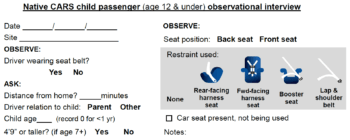Begin by Conducting a Child Safety Seat Survey in your community –
This is an important step towards reducing motor vehicle injuries. It sends the message that people care about this issue, child safety seat use is a priority, and people are paying attention to how kids ride in vehicles. It can also help you shape your campaign, strategically focus your efforts, and set goals for your community.
There are two types of assessments you can choose to conduct in your community
Survey Type #1: No-Contact Observational Data Collection
Download here: Word | PDF
This type of survey is less time intensive and may be an option if resources are limited. It also meets the data requirement to apply for Indian Highway Safety Program funds. However, you will not know if the child is properly restrained, just that they either are or are not retrained from your point of view while conducting observations.
If you want to know the proportion of children using any type of restraint in a vehicle, use this observation method here.
Survey Type #2: Contact Observational Data Collection
If you would like to know the proportion of children riding in an age and size appropriate restraint, such as rear-facing infant seats, forward-facing harness seats, booster seats, as well as regular seat belts, use the Native CARS survey method presented in this module. This type of survey gives you detailed insight into child safety seat use in your community.
You will then know where to focus your time and resources, because you will know which children are at highest risk for riding improperly restrained.
A Tip from the Team:
Here are some examples of how survey information helped tribes focus their efforts.
Example: Tribe A discovered that children age 4-7 were using adult seat belts without a booster seat. They did school outreach and a media campaign promoting booster seat use. When they repeated the survey two years later, they saw a significant increase in booster seat use in the tribe.
Example: Tribe B discovered that children riding with someone other than his or her own parent were less likely to be properly restrained. The tribe extended their child safety seat distribution program to include grandparents, aunties, or others who regularly transport children. They created posters and billboards showing grandparents securing their grandchildren in child safety seats. Two years later, they saw a significant increase in child safety seat use for children riding with grandparents.
The survey includes observations and questions that you need to determine if the child is in the correct restraint, along with additional things that have been shown to be related to proper child restraint. Collecting this information will tell you if these are also risk factors in your community.
Each survey takes about 1-2 minutes, depending on how many children are in the vehicle. If there are more than two children in the vehicle, use multiple survey forms and fill in the child passenger section for child #3, 4, and so on.
The Survey

Paper Survey Contact Version (25 copies): Word | PDF

Paper Survey No Contact Version (25 copies): Word | PDF
If your tribe is considering changing tribal child safety seat policy, you can document community support for it by adding an additional question to the survey, such as:
- Would you support a tribal child safety seat law?
Reach out to Olivia at owhiting@npaihb.org if you’d like to include additional questions to the survey.
